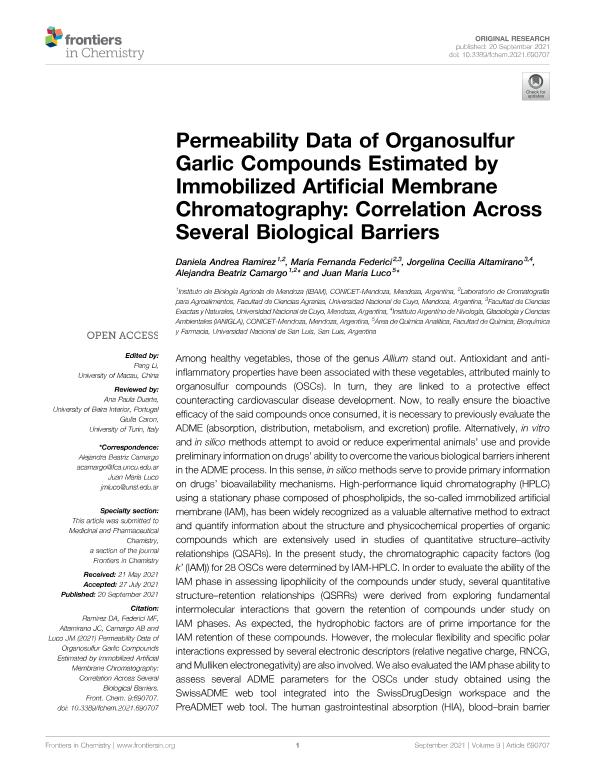Mostrar el registro sencillo del ítem
dc.contributor.author
Ramirez, Daniela Andrea

dc.contributor.author
Federici, Maria Fernanda
dc.contributor.author
Altamirano, Jorgelina Cecilia

dc.contributor.author
Camargo, Alejandra Beatriz

dc.contributor.author
Luco, Juan María
dc.date.available
2022-07-08T15:06:11Z
dc.date.issued
2021-09
dc.identifier.citation
Ramirez, Daniela Andrea; Federici, Maria Fernanda; Altamirano, Jorgelina Cecilia; Camargo, Alejandra Beatriz; Luco, Juan María; Permeability data of organosulfur garlic compounds estimated by immobilized artificial membrane chromatography: correlation across several biological barriers; Frontiers Media; Frontiers in Chemistry; 9; 9-2021; 1-13
dc.identifier.issn
2296-2646
dc.identifier.uri
http://hdl.handle.net/11336/161715
dc.description.abstract
Among healthy vegetables, those of the genus Allium stand out. Antioxidant and anti-inflammatory properties have been associated with these vegetables, attributed mainly to organosulfur compounds (OSCs). In turn, they are linked to a protective effect counteracting cardiovascular disease development. Now, to really ensure the bioactive efficacy of the said compounds once consumed, it is necessary to previously evaluate the ADME (absorption, distribution, metabolism, and excretion) profile. Alternatively, in vitro and in silico methods attempt to avoid or reduce experimental animals’ use and provide preliminary information on drugs’ ability to overcome the various biological barriers inherent in the ADME process. In this sense, in silico methods serve to provide primary information on drugs’ bioavailability mechanisms. High-performance liquid chromatography (HPLC) using a stationary phase composed of phospholipids, the so-called immobilized artificial membrane (IAM), has been widely recognized as a valuable alternative method to extract and quantify information about the structure and physicochemical properties of organic compounds which are extensively used in studies of quantitative structure–activity relationships (QSARs). In the present study, the chromatographic capacity factors (log k’ (IAM)) for 28 OSCs were determined by IAM-HPLC. In order to evaluate the ability of the IAM phase in assessing lipophilicity of the compounds under study, several quantitative structure–retention relationships (QSRRs) were derived from exploring fundamental intermolecular interactions that govern the retention of compounds under study on IAM phases. As expected, the hydrophobic factors are of prime importance for the IAM retention of these compounds. However, the molecular flexibility and specific polar interactions expressed by several electronic descriptors (relative negative charge, RNCG, and Mulliken electronegativity) are also involved. We also evaluated the IAM phase ability to assess several ADME parameters for the OSCs under study obtained using the SwissADME web tool integrated into the SwissDrugDesign workspace and the PreADMET web tool. The human gastrointestinal absorption (HIA), blood–brain barrier (BBB) permeation, and skin permeability were investigated through QSAR modeling, using several chemometric approaches. The ADME properties under study are strongly dependent on hydrophobic factors as expressed by log k’(IAM), which provide evidence for the great potential of the IAM phases in the development of QSAR models.
dc.format
application/pdf
dc.language.iso
eng
dc.publisher
Frontiers Media

dc.rights
info:eu-repo/semantics/openAccess
dc.rights.uri
https://creativecommons.org/licenses/by/2.5/ar/
dc.subject
BIOLOGICAL BARRIER
dc.subject
IAM
dc.subject
ORGANOSULFUR COMPOUNDS
dc.subject
PERMEABILITY
dc.subject
QSAR
dc.subject.classification
Otras Ciencias Químicas

dc.subject.classification
Ciencias Químicas

dc.subject.classification
CIENCIAS NATURALES Y EXACTAS

dc.title
Permeability data of organosulfur garlic compounds estimated by immobilized artificial membrane chromatography: correlation across several biological barriers
dc.type
info:eu-repo/semantics/article
dc.type
info:ar-repo/semantics/artículo
dc.type
info:eu-repo/semantics/publishedVersion
dc.date.updated
2022-07-04T20:03:14Z
dc.journal.volume
9
dc.journal.pagination
1-13
dc.journal.pais
Suiza

dc.description.fil
Fil: Ramirez, Daniela Andrea. Consejo Nacional de Investigaciones Científicas y Técnicas. Centro Científico Tecnológico Conicet - Mendoza. Instituto de Biología Agrícola de Mendoza. Universidad Nacional de Cuyo. Facultad de Ciencias Agrarias. Instituto de Biología Agrícola de Mendoza; Argentina
dc.description.fil
Fil: Federici, Maria Fernanda. Universidad Nacional de Cuyo; Argentina
dc.description.fil
Fil: Altamirano, Jorgelina Cecilia. Consejo Nacional de Investigaciones Científicas y Técnicas. Centro Científico Tecnológico Conicet - Mendoza. Instituto Argentino de Nivología, Glaciología y Ciencias Ambientales. Museo de Historia Natural de San Rafael - Ianigla | Provincia de Mendoza. Instituto Argentino de Nivología, Glaciología y Ciencias Ambientales. Museo de Historia Natural de San Rafael - Ianigla | Universidad Nacional de Cuyo. Instituto Argentino de Nivología, Glaciología y Ciencias Ambientales. Museo de Historia Natural de San Rafael - Ianigla; Argentina
dc.description.fil
Fil: Camargo, Alejandra Beatriz. Consejo Nacional de Investigaciones Científicas y Técnicas. Centro Científico Tecnológico Conicet - Mendoza. Instituto de Biología Agrícola de Mendoza. Universidad Nacional de Cuyo. Facultad de Ciencias Agrarias. Instituto de Biología Agrícola de Mendoza; Argentina
dc.description.fil
Fil: Luco, Juan María. Universidad Nacional de San Luis. Facultad de Química, Bioquímica y Farmacia; Argentina
dc.journal.title
Frontiers in Chemistry
dc.relation.alternativeid
info:eu-repo/semantics/altIdentifier/doi/http://dx.doi.org/10.3389/fchem.2021.690707
dc.relation.alternativeid
info:eu-repo/semantics/altIdentifier/url/https://www.frontiersin.org/articles/10.3389/fchem.2021.690707/full
Archivos asociados
